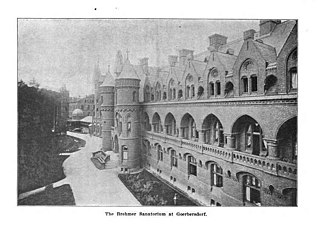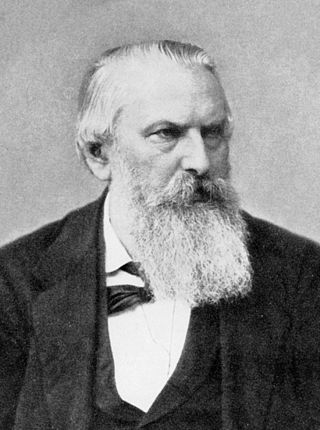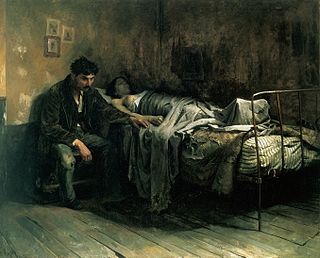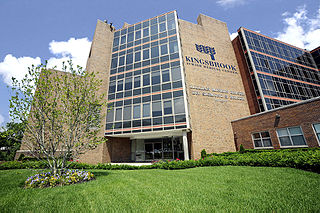
A sanatorium, also sanitarium or sanitorium, are antiquated names for specialised hospitals, for the treatment of specific diseases, related ailments and convalescence. Sanatoriums are often in a healthy climate, usually in the countryside. The idea of healing was an important reason for the historical wave of establishments of sanatoriums, especially at the end of the 19th- and early 20th centuries. One sought, for instance, the healing of consumptives, especially tuberculosis or alcoholism, but also of more obscure addictions and longings of hysteria, masturbation, fatigue and emotional exhaustion. Facility operators were often charitable associations such as the Order of St. John and the newly founded social welfare insurance companies.

Montefiore Medical Center is a premier academic medical center and the primary teaching hospital of the Albert Einstein College of Medicine in the Bronx, New York City. Its main campus, the Henry and Lucy Moses Division, is located in the Norwood section of the northern Bronx. It is named for Moses Montefiore and is one of the 50 largest employers in New York. In 2020, Montefiore was ranked No. 6 New York City metropolitan area hospitals by U.S. News & World Report. Adjacent to the main hospital is the Children's Hospital at Montefiore, which serves infants, children, teens, and young adults aged 0–21.

Between 1873 and 1945, Saranac Lake, New York, became a world-renowned center for the treatment of tuberculosis, using a treatment that involved exposing patients to as much fresh air as possible under conditions of complete bed-rest. In the process, a specific building type, the "cure cottage", developed, built by residents seeking to capitalize on the town's fame, by physicians, and often by the patients themselves. Many of these structures are extant, and their historic value has been recognized by listing on The National Register of Historic Places.

Hermann Brehmer was a German physician who established the first German sanatorium for the systematic open-air treatment of tuberculosis.

Glen Lake Sanatorium, a tuberculosis treatment center serving Hennepin County in Minnesota, opened on January 4, 1916, with a capacity of 50 patients, and closed in 1976. In 1909, the Minnesota State Legislature had passed a bill authorizing the appointment of county sanatorium boards and appropriating money for the construction of county sanatoriums. Glen Lake Sanatorium was the fifth of fourteen county sanatoria that opened in Minnesota between 1912 and 1918. Glen Lake was the first U.S. tuberculosis sanatorium to be accredited by the American Medical Association.The sanatorium had its own post office, and the mailing address was Glen Lake Sanatorium, Oak Terrace, Minnesota, until the surrounding area was incorporated into the City of Minnetonka.

The history of tuberculosis encompasses the origins of the disease, tuberculosis (TB) through to the vaccines and treatments methods developed to contain and mitigate its impact.
The Rutland Heights State Hospital was a state sanatorium for the treatment of pulmonary tuberculosis located in Rutland, Massachusetts, USA built for the purpose of treating Tuberculosis patients. The facility was the first state-operated sanatorium in the United States, opening in 1898 and operating for around 93 years before its closure in 1991. Rutland Heights opened under the title “Massachusetts Hospital for Consumptives and Tubercular Patients,” to which it operated until 1900, where it was renamed to “Massachusetts State Sanatorium.” In 1919 it was renamed to “Rutland State Sanatorium,” which was the longest operating name of the hospital, effective until 1963. In 1963, it was renamed briefly to “Rutland Hospital,” and successively in 1965 to “Rutland Heights State Hospital,” which was the final title of the hospital until closing. In 2004, the hospital was demolished.

The Minnesota State Sanatorium for Consumptives, also known as the Ah-Gwah-Ching Center, was opened in 1907 to treat tuberculosis patients. The name "Ah-Gwah-Ching" means "out-of-doors" in the Ojibwe language. The center remained a treatment center for tuberculosis until January 1, 1962. During that time, it treated nearly 14,000 patients. In 1962, it became a state nursing home known as the Ah-Gwah-Ching Nursing Home, serving geriatric patients with various mental and physical illnesses. At its peak in the 1970s, the nursing home had as many as 462 patients.
The town of Colorado Springs, Colorado, played an important role in the history of tuberculosis in the era before antituberculosis drugs and vaccines. Tuberculosis management before this era was difficult and often of limited effect. In the 19th century, a movement for tuberculosis treatment in hospital-like facilities called sanatoriums became prominent, especially in Europe and North America. Thus people sought tuberculosis treatment in Colorado Springs because of its dry climate and fresh mountain air. Some people stayed in boarding houses, while others sought the hospital-like facilities of sanatoriums. In the 1880s and 1890s, it is estimated that one-third of the people living in Colorado Springs had tuberculosis. The number of sanatoriums and hospitals increased into the twentieth century. During World War II, medicines were developed that successfully treated tuberculosis and by the late 1940s specialized tuberculosis treatment facilities were no longer needed.

The Oregon State Tuberculosis Hospital was a tuberculosis sanatorium in Salem, Oregon, United States. Established in 1905, it was the first public tuberculosis sanatorium on the West Coast. The main hospital building, constructed in 1894, had formerly housed the Oregon State Deaf-Mute School. After its conversion into the state tuberculosis hospital, multiple cottages and additional buildings were constructed on the property. The hospital remained in operation until 1969, when it was purchased by Corban University.

Ethan Allen School for Boys was a reform school in Delafield Town, Wisconsin which operated in a former tuberculosis sanitorium from April 1959 until June 2011, when it was abolished and the inmates moved to Lincoln Hills School in Irma. It was operated by the Wisconsin Department of Corrections.

Kingsbrook Jewish Medical Center is a 303-bed full-service community teaching hospital with an estimated 2,100 full-time employees, located in the neighborhood of East Flatbush in Brooklyn, New York. The hospital is made up of a complex of eight conjoined buildings which are dispersed over a 366,000 square foot city block.
Charles Emmanuel Reinhardt (1868–1920) was a British physician, animal welfare activist and anti-vivisectionist.
Hassler Health Farm, formerly known as San Francisco Health Farm between 1927 and 1931, was a tuberculosis sanatorium for patients of the San Francisco Bay Area, owned by the City of San Francisco. It was located in a remote part of San Mateo County, California, in what is today San Carlos, until 1964. After the discovery of antibiotics, tuberculosis became a reduced threat, leading the building to be converted into a hospital for the poor. It was closed in 1972 and sat empty until 1985, when the buildings were demolished. Today, the grounds are home to the 366-acre Pulgas Ridge Open Space Preserve.

Brooklyn Home for Consumptives was an American sanatorium located in Brooklyn, New York. Founded in 1881 as an almshouse, it was a purely benevolent and non-sectarian institution. It had two sections, one of which was attended by homoeopathic physicians and the other by allopathic practitioners, who treated the patients according to their choice. The home went through several changes before becoming the Brooklyn Hospital Center.

Montefiore Home for Chronic Invalids was an American sanatorium charity hospital. Founded in 1884 in Manhattan, New York at Avenue A and 84th Street, the sanatorium relocated to a larger building in Manhattan on 138th Street before removing to The Bronx in 1910. It also changed names several times.

Tuberculosis Preventorium for Children in Lakewood Township, New Jersey was the first preventorium in the United States. It opened in July 1909, as an expression of Nathan Straus' desire to prevent the spread of tuberculosis among children. The children were selected mainly by the Association of Tuberculosis Clinics and were passed upon by the Department of Health of New York City. There were 32 of these clinics, to the nearest of which the parents applied. No discrimination was made as to race or creed, and there was no charge for transportation or board.

St Joseph's Hospital for Consumptives, established in 1882 by Franciscan Sisters of the Third Order, was one of eight hospitals for people with tuberculosis in New York at the turn of the twentieth century.

















